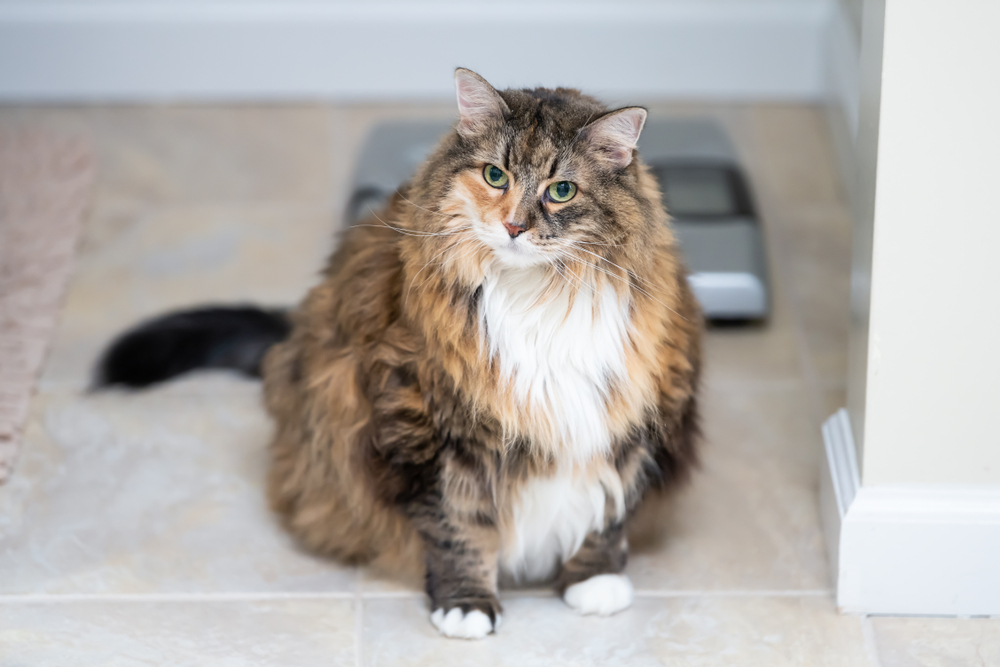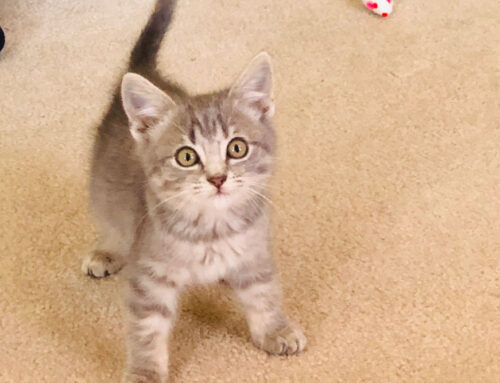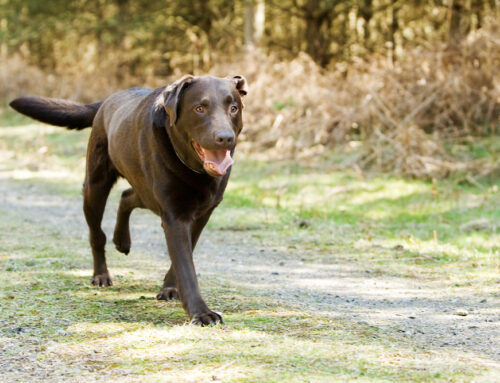Pet obesity is increasing, and the condition can raise your four-legged friend’s risk for significant health problems, such as diabetes, kidney disease, cancer, hypertension, arthritis, and skin disease. Our Liberty Veterinary Hospital team sees overweight pets every day, and we provide details about three fictional pet weight management cases.
Pet weight management case #1: Sophie, the overweight tabby cat
Sophie is a 4-year-old female tabby cat who came in for her annual wellness examination. Her owner lugged her in in a cat carrier that barely contained her girth. One of the first steps our team takes when performing a thorough wellness examination is to weigh your pet and assess their body condition score (BCS). We observe your pet from above and from the side and palpate certain body parts to assign them a score from one to nine, where one is emaciated, five is ideal, and nine is obese. Sophie’s BCS was eight, and she tipped the scale at 13 pounds. Studies show that obese cats live shorter lives and are less energetic and playful than felines with a healthy weight, and we recommended a weight loss program to help Sophie get to her ideal weight. Specifics included:
- Goal — We set Sophie’s goal as an end weight of 10 pounds, and aimed for her to lose about one pound per month.
- Prescription diet food — We prescribed a diet food to ensure Sophie’s nutritional needs were met and to help her feel satiated while losing weight.
- Exercise plan — We recommended exercising Sophie for 15 to 20 minutes a day using a laser pointer or wand style toy to encourage her to run and jump.
- Separate feedings — Sophie lives in a multi-cat household, so we recommended her owner feed her separately and pick up any remaining food between feedings to ensure she isn’t getting too many calories.
- Frequent monitoring — We had Sophie’s owner weigh her once a week using a baby scale to monitor her progress.
Sophie achieved her ideal weight after four months of this weight loss program, and we placed her on a diet maintenance program to help keep her at a healthy weight. If your cat is overweight, consult our Liberty Veterinary Hospital team because sudden calorie restriction can lead to a severe condition called feline hepatic lipidosis.
Pet weight management case #2: Dandy, the overweight Yorkshire terrier
Dandy is an 8-year-old Yorkshire terrier whose owner noticed he had gained weight over the past several months despite no change in his diet. Dandy’s owner also reported that he seemed to be drinking and urinating more and was less active. On examination, Dandy’s BCS was seven, his hair coat was thin, and he had a slight pot-bellied appearance. Our team suspected he had an underlying medical condition, so we ran some diagnostic tests and determined he had Cushing’s disease (i.e., hyperadrenocorticism). Our treatment plan included:
- Medication — We prescribed a prescription oral medication to manage Dandy’s Cushing’s disease.
- Diet — Our team prescribed a high-quality adult dog food designed to help prevent weight gain.
- Monitoring — We monitored Dandy’s weight and adrenocorticotropic hormone (ACTH) levels regularly to evaluate his progress.
Once we got Dandy’s Cushing’s disease under control, he rapidly lost the excess weight. He continues to take his Cushing’s medication to control the condition, and we evaluate his ACTH levels every few months.
Pet weight management case #3: Scout, the ideal weight Labrador retriever

Scout is a 2-year-old Labrador retriever whose BCS is five, and his owner asked our team for tips to keep him at a healthy weight. Tips we offered included:
- Calculating daily caloric needs — Using Scout’s weight, breed, age, and activity level, his owner calculated his daily caloric needs.
- Measuring meal portions — We recommended using a kitchen scale or measuring cup to accurately determine Scout’s meal portions to ensure he receives the right amount.
- Limiting treats — Our team advised Scout’s owner to limit his treats to no more than 10% of his daily calories and to choose healthy options, such as baby carrots and green beans.
- Exercising Scout — We recommended Scout get adequate daily exercise to help keep him fit and trim.
- Assessing body condition score — Our team showed Scout’s owner how to assess his pet’s BCS and recommended evaluating him once every two to three months to ensure he remains at a healthy weight.
- Scheduling regular wellness visits — Regular wellness visits help our team detect conditions, such as Cushing’s disease, that can affect your pet’s weight, and we recommended annual wellness visits for Scout.
- Involving the entire family — If one family member sneaks a pet table scraps, the pet’s weight management plan can be derailed. We recommended everyone in the family be educated about the importance of keeping Scout at a healthy weight so that no one was tempted to sneak him excess treats.
If your pet is overweight, or if you need to schedule your pet’s annual wellness examination, contact our American Animal Hospital Association (AAHA) accredited team at Liberty Veterinary Hospital so we can help keep your furry pal at an ideal weight.








Leave A Comment